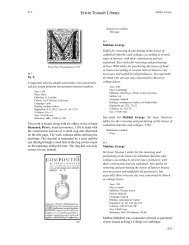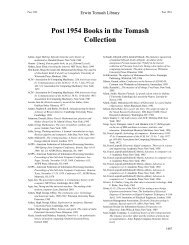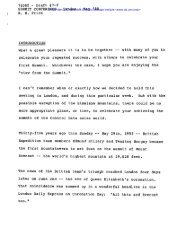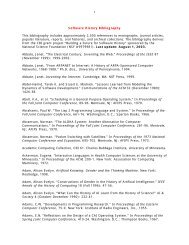B chapter.indd - Charles Babbage Institute - University of Minnesota
B chapter.indd - Charles Babbage Institute - University of Minnesota
B chapter.indd - Charles Babbage Institute - University of Minnesota
You also want an ePaper? Increase the reach of your titles
YUMPU automatically turns print PDFs into web optimized ePapers that Google loves.
Erwin Tomash Library<br />
<strong>Babbage</strong>, <strong>Charles</strong> <strong>Babbage</strong>, <strong>Charles</strong><br />
This paper is indicative <strong>of</strong> <strong>Babbage</strong>’s wide range <strong>of</strong><br />
interests and his willingness to apply his intellect to a<br />
variety <strong>of</strong> topics. It is a short description <strong>of</strong> an anglemeasuring<br />
device <strong>of</strong> his invention. Previous astronomical<br />
angular measurement systems relied on a finely divided<br />
scale that could be read by the aid <strong>of</strong> a magnifying glass.<br />
<strong>Babbage</strong> proposes a system in which a telescope is<br />
attached to one arm <strong>of</strong> a parallelogram; any shift <strong>of</strong> the<br />
configuration <strong>of</strong> the parallelogram being magnified by<br />
attachments to the other arms makes it easy to determine<br />
the angle <strong>of</strong> shift. There is one small figure describing the<br />
system that is to be found as part <strong>of</strong> the plate illustrating<br />
the previous paper in the volume.<br />
Illustrations available:<br />
None<br />
B 37<br />
<strong>Babbage</strong>, <strong>Charles</strong> (1791–1871)<br />
The ninth Bridgewater treatise, a fragment.<br />
Year: 1837<br />
Place: London<br />
Publisher: John Murray<br />
Edition: 1st<br />
Language: English<br />
Binding: original cloth boards<br />
Pagination: pp. [4], xxii (iii misnumbered as i), 23–240, (103<br />
misnumbered as 101),[2], 8<br />
Collation: π 2 B–Q 8 R 1 χ 4<br />
Size: 225x142 mm<br />
Reference: Van S CBCP, #70; Babb CBLP, #71, #73; Ran<br />
ODC, p. 405; MCK CBCW, v. 9<br />
As modern science began to conflict with traditional<br />
religious values, in 1829 the Earl <strong>of</strong> Bridgewater (Rev.<br />
Francis Egerton, F.R.S.) left the Royal Society a bequest<br />
<strong>of</strong> £8,000 to pay for the writing <strong>of</strong> several books on the<br />
Power, Wisdom and Goodness <strong>of</strong> God, as manifested<br />
in the Creation. Eight <strong>of</strong> these treatises were produced,<br />
but none seems to have had lasting value. The most<br />
successful treatise, titled Astronomy and general physics,<br />
was written by William Whewell, a tutor <strong>of</strong> mathematics<br />
at Cambridge. In it, Whewell condemned the growing<br />
influence <strong>of</strong> scientists and mathematicians and described<br />
them as mechanical philosophers without any authority<br />
with regard to their view <strong>of</strong> the administration <strong>of</strong> the<br />
Universe. In passing, Whewell singled out mechanized<br />
analytical calculation for particular condemnation.<br />
<strong>Babbage</strong> felt the need to respond and privately produced<br />
this un<strong>of</strong>ficial Ninth treatise. The work is curious in<br />
that <strong>Babbage</strong> decided to leave large sections blank (or<br />
perhaps removed them before publication)—hence the<br />
term fragment in the title. Martin Campbell-Kelly (The<br />
Works <strong>of</strong> <strong>Charles</strong> <strong>Babbage</strong>) reports that it had been<br />
suggested that some may have been removed after<br />
<strong>Babbage</strong>’s friends, upon reading the pro<strong>of</strong>s, objected to<br />
certain passages.<br />
The work argues for example, that miracles can easily<br />
occur without divine intervention and gives examples<br />
relating to his calculating machines and mathematics<br />
in general. The appendix contains a section on the<br />
calculating engine.<br />
For a modern discussion, see Topham, J., “Science and<br />
popular education: The role <strong>of</strong> the Bridgewater treatises,”<br />
British Journal for the History <strong>of</strong> Science, Vol. 25, 1992,<br />
pp. 397–430.<br />
Illustrations available:<br />
Title page<br />
B 38<br />
<strong>Babbage</strong>, <strong>Charles</strong> (1791–1871)<br />
The ninth Bridgewater treatise, a fragment.<br />
Year: 1838<br />
Place: London<br />
Publisher: John Murray<br />
Edition: 2nd<br />
Language: English<br />
Binding: original cloth boards<br />
Pagination: pp. viii, xxii, 23–270, [14]<br />
Collation: A 4 B–S 8 χ 6<br />
Size: 223x140 mm<br />
Reference: Van S CBCP, #70; Babb CBLP, #71, #73; Ran<br />
ODC, p. 405; MCK CBCW, v. 9<br />
B 37<br />
81







